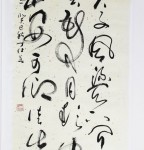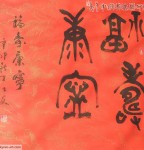Mount Heng, Heng Shan or Heng Mountain (simplified Chinese: 恒山; traditional Chinese: 恆山; pinyin: Héng Shān) in Shanxi Province of China is one of the Five Sacred Mountains of Taoism. At 2,017 m, it is one of the five tallest peaks in China Proper. Heng Shan in Shanxi Province is sometimes known as the Northern Heng Shan, and the one in Hunan Province as Southern Heng Shan (simplified Chinese: 衡山; pinyin: Héng Shān). Both mountains have the same pronunciation in Chinese, and the Southern Heng Shan is also one of the Five Sacred Mountains.
Qinyuanchun , Mount Heng - By Ding Shiemei
力拔千宗,气贯洪荒,峦叠万重。
叹峰岭涌翠,涧峡流韵;
阴涔蠕蟒,雁塞翔鸿。
北瞰云幽,南凌三晋,跨太行苍龙跃空。
烟涛里,矗峥嵘百柱,擎起穹窿!
虎风飞窟虬松,观滚滚红尘弥九阍。
昔舜骚鸾凤,秦惊猢狖;
汉驰车骥,魏展蜺虹。
唐赋辞章,宋仪遥祝,明祀清祈噪大雄。
谁曾似,果老仙逍放, 踪迹犹存?
Autumn 1992
History
Like the other four sacred Daoist mountains in China, Heng Shan has been considered a sacred mountain since the Zhou Dynasty. Due to its northerly location, the mountain has made it impossible for pilgrimages by the Chinese to take place for much of its history. Because of this, Hengshan is not nearly as religiously important in China as the other four Daoist mountains.
Temples
During the Han Dynasty, a temple called the Shrine of the Northern Peak (Beiyue Miao), dedicated to the mountain god was built on Hengshan's slopes. While periodically destroyed and rebuilt, this temple has an uninterrupted history from Han times to the present day.During times of occupation by non-Han Chinese people, worship to Hengshan was done at the Beiyue Temple in Quyang.
The most famous temple at Hengshan is not Daoist, but is actually the Buddhist Hanging Monastery (Xuankong Si). The Hanging Monastery stands at the foot of Mt. Hengshan and is one of the most dramatic sights at Hengshan - a wooden temple clinging to the cliff side, appearing to defy gravity with only a few wooden posts as support. The Hanging Monastery, built in 491, has survived more than 1,400 years. The extant monastery was largely rebuilt and maintained in the Ming Dynasty (1368–1644) and Qing Dynasty (1644–1911). The buildings were restored in 1900 and there are 40 wooden halls and structures linked by an ingenious system of pillars, posts and walkways.
| < Prev | Next > |
|---|
- 2020-08-09 - 读海(之一)
- 2020-07-27 - 丁仕美书法及诗歌作品《纯情吟》
- 2020-05-14 - 右玉城
- 2020-01-28 - 血墨
- 2011-05-13 - New York Times: The Poetry of Hangzhou, China
- 2009-08-13 - 水调歌头 —谒关帝
- 2009-07-28 - 河东行--长诗
- 2008-11-19 - 西北咏风 - 五律
- 2008-11-15 - 琵琶吟
- 2008-11-10 - 征鸿颂














